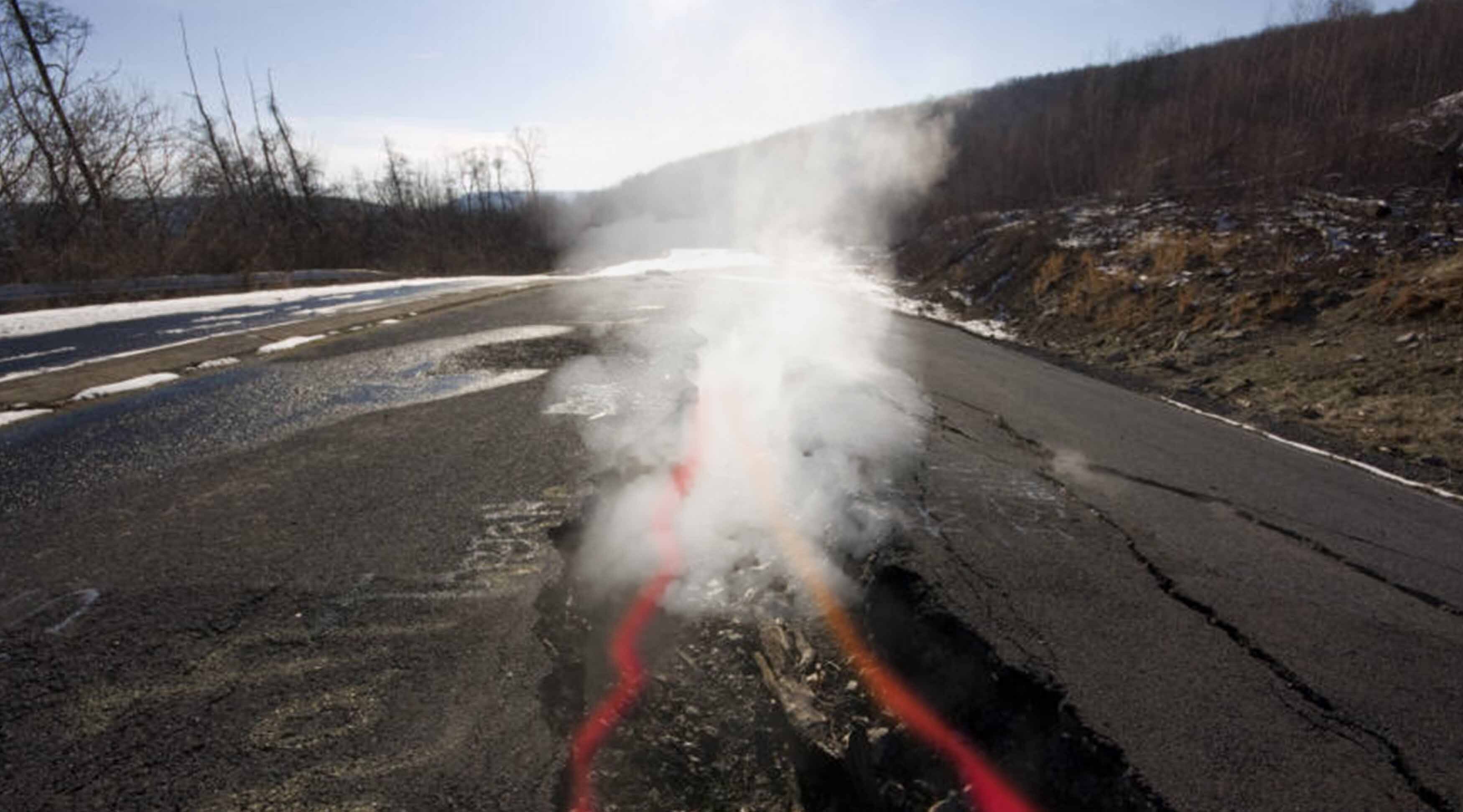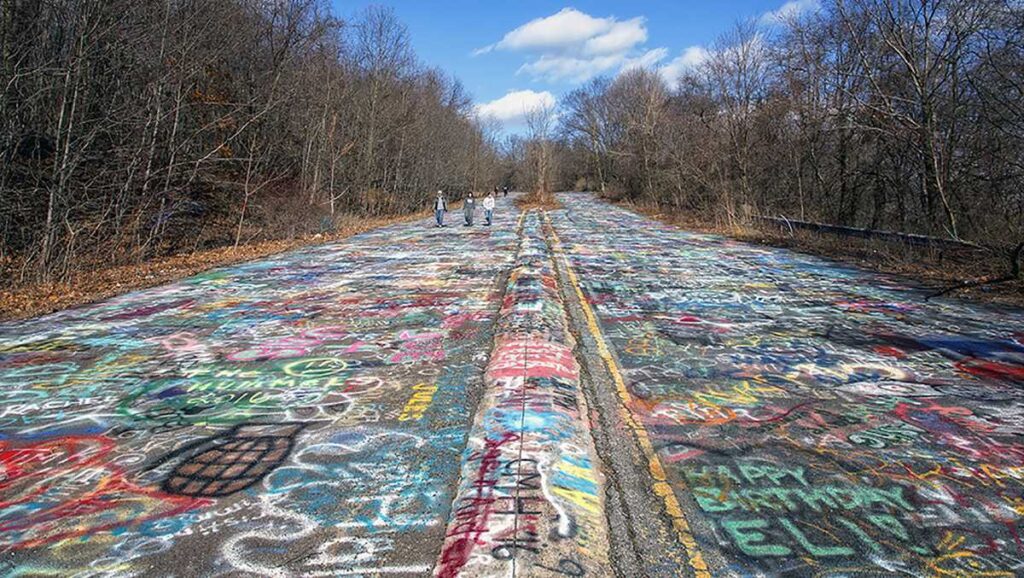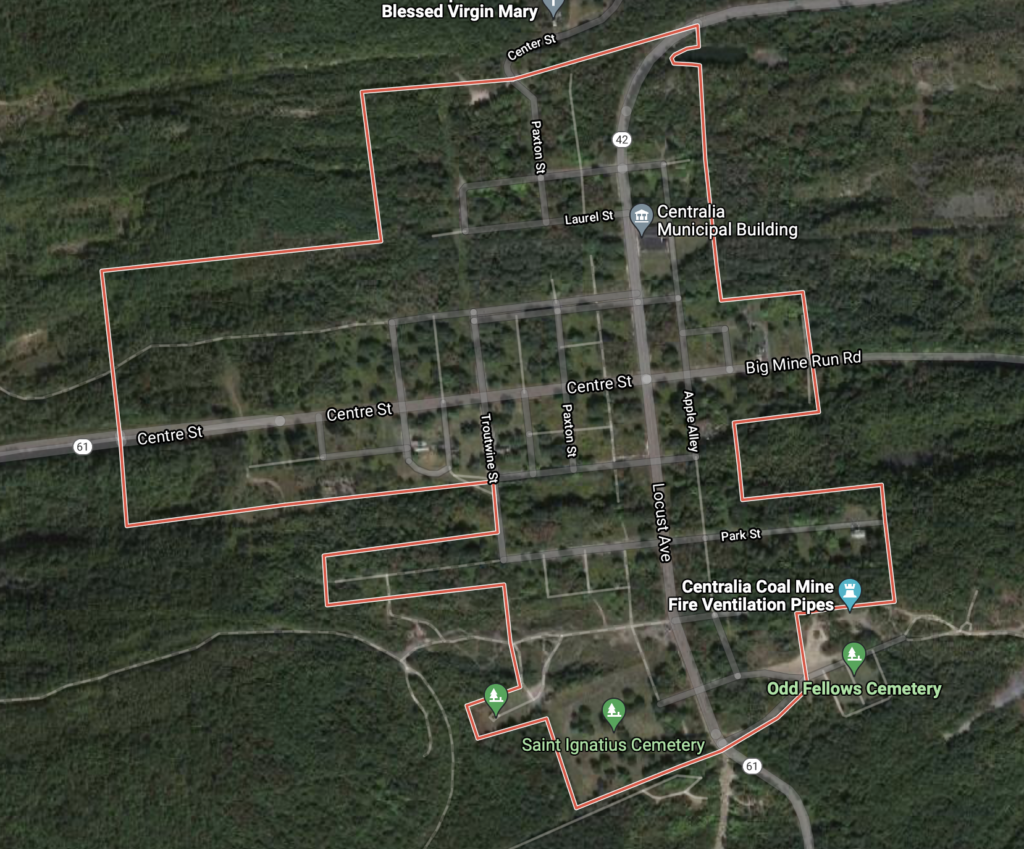A Fire Burning Underground: Centralia, PA
At the time of its largest population, Centralia, PA was an Eastern Pennsylvania borough with 2,700 residents. Now there are 5. This is due to a coal fire that’s been burning under the town for almost 60 years, and continues to burn to this day. In this episode, we tell the sad story of Centralia and chat with Entertainer Scot Nery for the quick quiz!

Sometimes cities just…disappear. And throughout history, we’ve seen it happen for all kinds of reasons. Sometimes the industry that built the city dies and we’re left with the skeleton of a mining town or a closed auto plant. Or maybe you built your city next to Mount Vesuvius and in 79 AD your entire population was buried by volcanic ash. Towns that have been buried by water are so common, they even have a sub genre of crime novels called “reservoir noir.” In Famagusta Cyprus, the whole town was forced to evacuate in 1974 because of the Turkish invasion and the city has remained a ghost town for almost 50 years. The same could be said for Pripyat, Ukraine a city that hasn’t seen inhabitants since the nearby Chernobyl Power Plant experienced a nuclear meltdown in 1986.
Like many of these abandoned cities and towns, the story of Centralia, Pennsylvania is a story of a once-thriving community that has completely disappeared. It was settled in 1841 as the town of Bull’s Head, but when anthracite coal was discovered, the town was purchased by the Locust Mountain Iron and Coal Company and renamed to Centralia in 1865. The Mining Engineer Alexander Rae laid out the streets and lots that you can still see from Google Maps today. They began mining the coal and a railroad line was built to transport the coal out of the borough. In that decade, 5 coal mines were opened around the town and the population starting growing. As did the crime. Alexander Rae was murdered by an Irish Gang called the Molly Maguires in 1868. This was followed by years of violence by the group, which was fighting for the rights of coal miners against what they saw as oppressive employers taking advantage of its workers. Three of the Molly Maguire members were found guilty of the murder and hanged. Violence between the immigrant workers and the mine’s proprietors continued for decades.
By 1890, the town of Centralia had grown to a population of just under 3,000 residents. It had 5 hotels, 7 churches, and dozens of stores and businesses. Today, the population is 5. Not 5,000. 5 residents. That’s because for more than 50 years, the earth below Centralia, Pennsylvania has been on fire.
In the late 1950s and early 1960s, the borough of Centralia, Pennsylvania had a population of almost 2,000 residents. While the main 5 mines that powered the town had long been shut down, lots of bootleg mining, strip mining and open-pit mining was happening in the region. The town was functioning as any normal Eastern Pennsylvania community.
But then the Centralia City Council decided to clean up for its Memorial Day celebration. The plan was to do what they had done in previous years: have the volunteer fire department burn the trash in the nearby trash pit. Well in 1962, that trash pit had been relocated to an abandoned strip mining pit near the city’s small cemetery. Like previous years, the firefighters started the controlled burn of trash and let it burn.
But there was a problem. Exposed veins from the anthracite coal mines below were slowly ignited by the fire above and this started a fire in those coal mines deep below the town. There was supposed to be a layer of clay between each layer of the landfill, but the city had fallen behind schedule, so it wan’t completed. The hot coals from the burning trash made contact with those coal veins. The fire underground burned slowly. Almost too slowly to notice.
Citizens of the town argued for years whether or not the fire underground even existed. Some people said it was a myth. Others argued about how exactly the fire started. Some said it was a fire that was slowly burning underground as far back as 1932 and took that long to extend to the landfill area. But by 1979, there was no question that the fire was burning underground. A local gas station owner was checking the fluid level of one of his underground tanks and noticed that the dipstick came out steaming hot. It turned out the temperature of his gasoline was 172 degrees Fahrenheit.
2 years after that, a 12 year old boy had to be rescued from a sinkhole that opened up in his backyard. If falling into the sinkhole wasn’t bad enough, it was billowing steam and lethal levels of carbon monoxide. Holes and cracks began opening in roads, producing columns of dangerous smoke and fumes, including state route 61, which runs through the town. An entire section of the road was shut down and rerouted. Despite the horrible conditions below the town, some residents living in the homes above fought to stay.
In 1982, $42 million dollars was allocated by Congress to help the citizens of Centralia move. Most of the citizens took the money and moved out. 500 structures were demolished. 63 residents were holdouts and insisted on staying. A decade later, Governor Bob Casey declared the town condemned. He invoked eminent domain on the town. The Postal Service removed the town’s zip code. By 2010, only five homes remained. The town has been almost completely wiped out. Experts say the fire may continue to burn for another 250 years.


If you look look at Centralia, PA on google maps, you’ll see what the town used to be. You’ll see the neatly laid out streets. The main intersection of town at Locust Avenue and Centre Street is now overgrown with weeds and trees. There are only a few homes left. Over the years, the part of State Route 61 that was shut down became known as graffiti highway, as tourists would come into the unsafe area filled with toxic gas to paint their initial and take pictures of the smoking cracks in the road. But even that’s been covered up now. Volunteers came in in 2021 to plant 250 trees in an effort to help return the area to a habitable place for wildlife. There’s hardly anything left of Centralia. But there’s one church still standing. It’s a Ukranian Church that was built on top of solid rock – not coal mine. It’s still holding services every Sunday and many of the town’s former residents drive in to attend church, worship and get together and talk about the town that used to be…a town that just disappeared.
Sources for this episode:
https://www.centraliapa.org/about-centralia-pa-mine-fire/
https://web.archive.org/web/20121129045230/http://www.aolnews.com/2010/02/05/few-remain-as-1962-fire-still-burns-in-coal-town/
https://en.wikipedia.org/wiki/Centralia,_Pennsylvania
https://uncoveringpa.com/visiting-centralia


